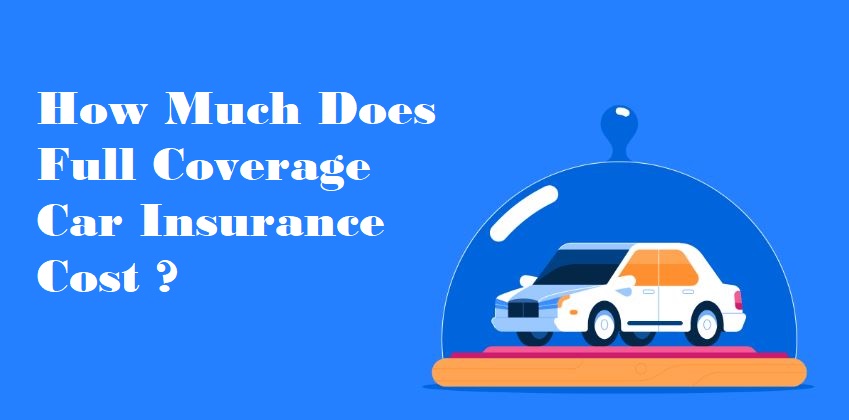Car insurance rates can vary significantly depending on a variety of factors. These include your personal demographics, the type of vehicle you drive, where you reside, and your driving history.
When it comes to car insurance, you may choose between minimum coverage and full coverage. Full coverage generally costs more than minimum coverage, but it provides you with greater financial protection for both you and your vehicle.
Insurance companies use these factors to assess the likelihood of future auto insurance claims and determine the probable cost of such claims.
If you’re curious to know how much full coverage car insurance usually costs, we can help you review the average cost of full coverage car insurance based on your state, credit score, gender, and insurance company.
We’ll also provide you with some tips to help you save on your insurance premiums while ensuring you have adequate coverage.

What Is Full Coverage Auto Insurance?
Full coverage auto insurance generally refers to a policy that includes liability, physical damage, and comprehensive and collision coverage. It usually exceeds the minimum coverage requirement mandated by the state.
A comprehensive and collision insurance policy typically provides insurance against damage that is not related to a car accident, such as theft or damage caused by the weather.
However, there is no standard definition of full coverage as different insurance companies offer varying types of coverage. Thus, it is advisable to compare auto insurance quotes from multiple providers, including the level of coverage each offers.
Average Rates by Insurance Company
The cost of full coverage car insurance varies greatly between providers. Below is a list of some of the largest insurance companies in the United States, according to Bankrate, with their average rates for full and minimum coverage:
- Allstate: $545 minimum coverage, $2,630 full coverage
- American Family: $606 minimum coverage, $1,700 full coverage
- Amica: $429 minimum coverage, $1,467 full coverage
- Auto-Owners: $325 minimum coverage, $1,361 full coverage
- Erie: $486 minimum coverage, $1,356 full coverage
- Farmers: $534 minimum coverage, $1,598 full coverage
- Geico: $373 minimum coverage, $1,353 full coverage
- Mercury: $541 minimum coverage, $1,547 full coverage
- Nationwide: $567 minimum coverage, $1,422 full coverage
- Progressive: $553 minimum coverage, $1,642 full coverage
- State Farm: $464 minimum coverage, $1,480 full coverage
- Travelers: $495 minimum coverage, $1,551 full coverage
- USAA (only for veterans, active military members, and their families): $371 minimum coverage, $1,361 full coverage
Average Auto Insurance Rates by State
The location where you reside impacts the amount you pay for comprehensive coverage. When assessing risk, car insurance providers take into account ZIP codes. If you dwell in a city that experiences high traffic or theft rates, you can anticipate a more expensive rate for collision or comprehensive insurance. Below are the average rates by state for full coverage car insurance:
- Alabama: $1,843 annually
- Alaska: $1,946 annually
- Arizona: $1,810 annually
- Arkansas: $1,907 annually
- California: $2,291 annually
- Colorado: $2,698 annually
- Connecticut: $1,533 annually
- Delaware: $2,103 annually
- District of Columbia: $2,072 annually
- Florida: $3,183 annually
- Georgia: $2,085 annually
- Hawaii: $1,275 annually
- Idaho: $1,133 annually
- Illinois: $1,806 annually
- Indiana: $1,295 annually
- Iowa: $1,315 annually
- Kansas: $1,878 annually
- Kentucky: $2,124 annually
- Louisiana: $2,909 annually
- Maine: $941 annually
- Maryland: $1,971 annually
- Massachusetts: $1,262 annually
- Michigan: $2,691 annually
- Minnesota: $1,760 annually
- Mississippi: $1,771 annually
- Missouri: $1,943 annually
- Montana: $1,889 annually
- Nebraska: $1,624 annually
- Nevada: $2,779 annually
- New Hampshire: $1,262 annually
- New Jersey: $1,754 annually
- New Mexico: $1,591 annually
- New York: $3,139 annually
- North Carolina: $1,446 annually
- North Dakota: $1,302 annually
- Ohio: $1,266 annually
- Oklahoma: $1,998 annually
- Oregon: $1,415 annually
- Pennsylvania: $2,040 annually
- Rhode Island: $1,886 annually
- South Carolina: $1,532 annually
- South Dakota: $1,552 annually
- Tennessee: $1,429 annually
- Texas: $2,019 annually
- Utah: $1,510 annually
- Vermont: $1,061 annually
- Virginia: $1,439 annually
- Washington: $1,410 annually
- West Virginia: $1,580 annually
- Wisconsin: $1,292 annually
- Wyoming: $1,582 annually
The most expensive state for full coverage auto insurance is New York, while Maine is the least expensive. It’s essential to be aware of your state’s minimum insurance requirements.
Auto Insurance by Credit Score
Credit score is a crucial factor that determines the pricing of auto insurance. Drivers with good to excellent credit scores are typically offered better rates.
Insurance companies often consider drivers with poor credit as more likely to file a claim, which increases the likelihood that they will be charged more for a full-coverage policy.
Auto insurance companies make use of credit-based insurance scores, which are different from traditional or FICO credit scores.
The primary difference between a credit-based insurance score and a FICO score lies in how they evaluate past payment history, current debt, and length of credit history.
According to the Federal Trade Commission (FTC), your credit-based insurance score is slightly more dependent on past payment history and less related to the types of credit used.
The rates offered by providers may vary depending on your credit score. Some companies may charge significantly different rates based on your credit score.
- Allstate
- Erie
- Farmers Insurance
- Frankenmuth
- Liberty Mutual
- Mercury
- Progressive
- State Farm
- Travelers Insurance
- USAA
- Safeco
- Shelter
- Nationwide
- NJM
- Esurance
- American Family
- Country Financial
It is a good idea to obtain a copy of your credit report before getting insurance quotes. This will help you understand how much your credit score may impact your insurance rates.
Boosting your credit score by even a small margin can lead to savings on a full coverage insurance policy. Moreover, some insurance companies may not increase your rates due to poor credit in specific situations, such as after a divorce.
Gender-Based Rates for Auto Insurance
It is important to note that your gender may have an impact on the cost of your full coverage auto insurance, however, other factors such as your accident history, credit score, state of residence, and insurance company have a greater influence on coverage prices.
It is illegal to price auto policies differently for men and women in seven US states, including California, Hawaii, Massachusetts, Michigan, Montana, North Carolina, and Pennsylvania.
In states that permit gender-based pricing, women pay, on average, slightly more than $50 annually compared to men for auto insurance.
When calculating the cost of full coverage car insurance, it is important to take into consideration your state, insurance provider, and factors such as gender. It is recommended to compare prices between providers in order to find the best rates.
Full Coverage Insurance Rates by Driving History
When it comes to buying auto insurance, your driving history is one of the most important factors. Your driving record includes information about traffic violations, such as DUIs, as well as details of any claims you have made with previous insurance companies. Several factors could impact your driving history, including:
- Number of accidents
- Number of at-fault accidents
- DUIs
- Speeding tickets
- Traffic violations
One of the most effective ways to qualify for the lowest insurance rates is by driving safely and avoiding traffic violations. It’s important to note that insurance providers might raise your rates after an accident or traffic violation. However, some insurance companies offer accident forgiveness, which means that you get one free pass.
Full Coverage Costs by Marital Status
It is important to note that your marital status can have an impact on your car insurance rates. According to the Insurance Information Institute (III), most married couples qualify for a discount on their car insurance.
This is because married drivers are more likely to be over 25 years old and have multiple cars on the same insurance policy, which can make them eligible for additional discounts.
However, some states have laws that prohibit insurance companies from factoring in marital status when calculating insurance rates. For instance, Hawaii, Massachusetts, and Montana do not permit insurance providers to use marital status as a criteria for determining car insurance risk.
Full Coverage Insurance Rates by Age
Age is a significant factor that insurance companies consider while determining your auto insurance premium. Younger and senior drivers are considered to be at the highest risk, as they are more likely to get into an accident and file a claim. Therefore, they can expect higher car insurance premiums. Here’s what you can expect to pay for car insurance on average based on your age:
- 20-year-old driver: $4,319 annually
- 25-year-old driver: $2,473 annually
- 30-year-old driver: $2,125 annually
- 40-year-old driver: $2,014 annually
- 50-year-old driver: $1,881 annually
- 60-year-old driver: $1,824 annually
- 70-year-old driver: $1,986 annually
Drivers with less experience, particularly younger ones, are at a higher risk of being involved in an accident. As a driver gains experience, the likelihood of accidents decreases, but the rates may begin to increase again as the driver gets older. To save money, it is a good idea to compare car insurance quotes from different companies at each milestone birthday.
While full coverage insurance for teen drivers is the most expensive, it is also important because they are more likely to file a claim and need sufficient coverage.
Teen drivers often earn less, making it harder to cover damages themselves if they don’t have enough insurance. Adding a teen driver to a policy may result in an increase in full coverage insurance rates for families. It is crucial to shop around to find affordable full coverage insurance for teen drivers.
How to Save on a Full Coverage Car Insurance Policy
Full coverage car insurance policies are more expensive than minimum coverage policies. However, you can still find the cheapest rates for full coverage by following these tips:
1. Pay a higher deductible: If you choose to pay a higher deductible, you will have to pay more out of your pocket when filing a claim. However, you will have a lower monthly premium payment.
2. Ask about discounts: Many auto insurance companies offer discounts on full-coverage policies. You may qualify for a discount if you are a good student, a good driver, accident-free, or have multiple policies.
3. Choose your vehicle carefully: Insurance premiums are calculated based on the cost of repairing or replacing your vehicle. Choosing a less expensive vehicle may qualify you for discounts.
4. Compare quotes frequently: Comparing quotes is one of the best ways to get the cheapest full coverage rates. Price-shop your insurance options at least once a year and consider new providers if you need to change your car insurance coverage.
5. Maintain a clean driving record: Keeping a clean driving record helps you control car insurance costs. An at-fault accident can easily increase your premium.
6. Choose a safe vehicle: Buying a vehicle with updated safety features can save you money on insurance. Hands-free driving technologies reduce the risk of accidents and may lead to a lower premium. Many insurance companies offer discounts for vehicles equipped with security devices.
7. Evaluate your coverage needs: Full coverage is recommended for expensive vehicles, and your lender or leasing company may require you to have it. However, once you pay off the loan and your vehicle is worth less, you may no longer need full coverage.
The cost of full coverage car insurance varies depending on many factors, and the national average cost is hard to determine. However, by choosing a safe vehicle and comparing quotes from the best car insurance companies, you can find a full coverage policy that fits your budget.






